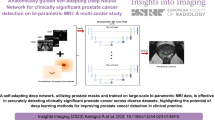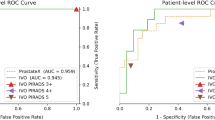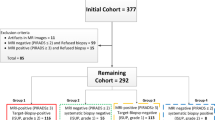Abstract
Purpose
To present fully automated DL-based prostate cancer detection system for prostate MRI.
Methods
MRI scans from two institutions, were used for algorithm training, validation, testing. MRI-visible lesions were contoured by an experienced radiologist. All lesions were biopsied using MRI-TRUS-guidance. Lesions masks, histopathological results were used as ground truth labels to train UNet, AH-Net architectures for prostate cancer lesion detection, segmentation. Algorithm was trained to detect any prostate cancer ≥ ISUP1. Detection sensitivity, positive predictive values, mean number of false positive lesions per patient were used as performance metrics.
Results
525 patients were included for training, validation, testing of the algorithm. Dataset was split into training (n = 368, 70%), validation (n = 79, 15%), test (n = 78, 15%) cohorts. Dice coefficients in training, validation sets were 0.403, 0.307, respectively, for AHNet model compared to 0.372, 0.287, respectively, for UNet model. In validation set, detection sensitivity was 70.9%, PPV was 35.5%, mean number of false positive lesions/patient was 1.41 (range 0–6) for UNet model compared to 74.4% detection sensitivity, 47.8% PPV, mean number of false positive lesions/patient was 0.87 (range 0–5) for AHNet model. In test set, detection sensitivity for UNet was 72.8% compared to 63.0% for AHNet, mean number of false positive lesions/patient was 1.90 (range 0–7), 1.40 (range 0–6) in UNet, AHNet models, respectively.
Conclusion
We developed a DL-based AI approach which predicts prostate cancer lesions at biparametric MRI with reasonable performance metrics. While false positive lesion calls remain as a challenge of AI-assisted detection algorithms, this system can be utilized as an adjunct tool by radiologists.




Similar content being viewed by others
Availability of data and material
ProstateX data are publicly available ((https://www.aapm.org/GrandChallenge/PROSTATEx-2/default.asp); NCI dataset is not publicly available.
Code availability
The code is available upon request.
References
Siegel RL, Miller KD, Jemal A. Cancer statistics, 2018. CA Cancer J Clin. 2018.
Schroder FH, Hugosson J, Roobol MJ, Tammela TL, Zappa M, Nelen V, et al. Screening and prostate cancer mortality: results of the European Randomised Study of Screening for Prostate Cancer (ERSPC) at 13 years of follow-up. Lancet. 2014;384:2027-35.
Han C, Zhu L, Liu X, Ma S, Liu Y, Wang X. Differential diagnosis of uncommon prostate diseases: combining mpMRI and clinical information. Insights into imaging. 2021;12(1):79.
Walker SM, Turkbey B. Role of mpMRI in Benign Prostatic Hyperplasia Assessment and Treatment. Current urology reports. 2020;21(12):55.
Brown AM, Elbuluk O, Mertan F, Sankineni S, Margolis DJ, Wood BJ, et al. Recent advances in image-guided targeted prostate biopsy. Abdominal imaging. 2015;40(6):1788-99.
Ahdoot M, Wilbur AR, Reese SE, Lebastchi AH, Mehralivand S, Gomella PT, et al. MRI-Targeted, Systematic, and Combined Biopsy for Prostate Cancer Diagnosis. N Engl J Med. 2020;382(10):917-28.
Turkbey B, Rosenkrantz AB, Haider MA, Padhani AR, Villeirs G, Macura KJ, et al. Prostate Imaging Reporting and Data System Version 2.1: 2019 Update of Prostate Imaging Reporting and Data System Version 2. European Urology. 2019;0232:1-12.
Girometti R, Giannarini G, Greco F, Isola M, Cereser L, Como G, et al. Interreader agreement of PI-RADS v. 2 in assessing prostate cancer with multiparametric MRI: A study using whole-mount histology as the standard of reference. Journal of Magnetic Resonance Imaging. 2019;49:546–55.
LeCun Y, Bengio Y, Hinton G. Deep learning. Nature. 2015;521(7553):436-44.
Schelb P, Kohl S, Radtke JP, Wiesenfarth M, Kickingereder P, Bickelhaupt S, et al. Classification of Cancer at Prostate MRI: Deep Learning versus Clinical PI-RADS Assessment. Radiology. 2019;293(3):607-17.
Winkel DJ, Tong A, Lou B, Kamen A, Comaniciu D, Disselhorst JA, et al. A Novel Deep Learning Based Computer-Aided Diagnosis System Improves the Accuracy and Efficiency of Radiologists in Reading Biparametric Magnetic Resonance Images of the Prostate: Results of a Multireader, Multicase Study. Investigative radiology. 2021;56(10):605-13.
Hosseinzadeh M, Saha A, Brand P, Slootweg I, de Rooij M, Huisman H. Deep learning-assisted prostate cancer detection on bi-parametric MRI: minimum training data size requirements and effect of prior knowledge. Eur Radiol. 2021.
Syer T, Mehta P, Antonelli M, Mallett S, Atkinson D, Ourselin S, et al. Artificial Intelligence Compared to Radiologists for the Initial Diagnosis of Prostate Cancer on Magnetic Resonance Imaging: A Systematic Review and Recommendations for Future Studies. Cancers. 2021;13(13).
Litjens G, Debats O, Barentsz J, Karssemeijer N, Huisman H. Computer-Aided Detection of Prostate Cancer in MRI. IEEE Transactions on Medical Imaging. 2014;33(5):1083-92.
Clark K, Vendt B, Smith K, Freymann J, Kirby J, Koppel P, et al. The Cancer Imaging Archive (TCIA): Maintaining and Operating a Public Information Repository. Journal of Digital Imaging. 2013;26(6):1045-57.
Siddiqui MM, Rais-Bahrami S, Turkbey B, George AK, Rothwax J, Shakir N, et al. Comparison of MR/ultrasound fusion-guided biopsy with ultrasound-guided biopsy for the diagnosis of prostate cancer. JAMA. 2015;313:390-7.
Turkbey B, Fotin SV, Huang RJ, Yin Y, Daar D, Aras O, et al. Fully automated prostate segmentation on MRI: comparison with manual segmentation methods and specimen volumes. AJR Am J Roentgenol. 2013;201:W720-9.
Epstein JI, Zelefsky MJ, Sjoberg DD, Nelson JB, Egevad L, Magi-Galluzzi C, et al. A Contemporary Prostate Cancer Grading System: A Validated Alternative to the Gleason Score. Eur Urol. 2016;69:428-35.
Çiçek Ö, Abdulkadir A, Lienkamp SS, Brox T, Ronneberger O, editors. 3D U-Net: Learning Dense Volumetric Segmentation from Sparse Annotation2016; Cham: Springer International Publishing.
Liu S, Xu D, Zhou SK, Pauly O, Grbic S, Mertelmeier T, et al., editors. 3D Anisotropic Hybrid Network: Transferring Convolutional Features from 2D Images to 3D Anisotropic Volumes2018; Cham: Springer International Publishing.
Milletari F, Navab N, Ahmadi S-AJFICoDV. V-Net: Fully Convolutional Neural Networks for Volumetric Medical Image Segmentation. 2016:565–71.
Diederik P. Kingma JB. Adam: A Method for Stochastic Optimization. ICLR (Poster). 2015.
Documentation CTS. Clara Train SDK Documentation.
Greer MD, Lay N, Shih JH, Barrett T, Bittencourt LK, Borofsky S, et al. Computer-aided diagnosis prior to conventional interpretation of prostate mpMRI: an international multi-reader study. Eur Radiol. 2018;28(10):4407-17.
Esteva A, Kuprel B, Novoa RA, Ko J, Swetter SM, Blau HM, et al. Dermatologist-level classification of skin cancer with deep neural networks. Nature. 2017;542(7639):115-8.
McKinney SM, Sieniek M, Godbole V, Godwin J, Antropova N, Ashrafian H, et al. International evaluation of an AI system for breast cancer screening. Nature. 2020;577(7788):89-94.
Saha A, Hosseinzadeh M, Huisman H. End-to-end prostate cancer detection in bpMRI via 3D CNNs: Effects of attention mechanisms, clinical priori and decoupled false positive reduction. Medical image analysis. 2021;73:102155.
Mehta P, Antonelli M, Ahmed HU, Emberton M, Punwani S, Ourselin S. Computer-aided diagnosis of prostate cancer using multiparametric MRI and clinical features: A patient-level classification framework. Med Image Anal. 2021;73:102153.
Funding
This research is funded by intramural research program of NIH.
Author information
Authors and Affiliations
Corresponding author
Ethics declarations
Conflict of interest
Author BJW is supported by the Intramural Research Program of the NIH and the NIH Center for Interventional Oncology and NIH Grant # Z1A CL040015-08. NIH and Philips/InVivo Inc have a cooperative Research and Development Agreement. NIH and Philips/InVivo Inc have a patent license agreement and NIH and BJW, BT, PAP, PLC may receive royalties. DY, DZ, HR, ZX are NVIDIA Cooperation employees. The remaining authors have no disclosures.
Ethical approval
All procedures performed in studies involving human participants were in accordance with the ethical standards of the institutional and/or national research committee and with the 1964 Helsinki declaration and its later amendments or comparable ethical standards.
Consent to participate
Informed consent was obtained from all individual participants included in the study.
Consent for publication
All coauthors are aware of submission of this work and they approved the submission.
Additional information
Publisher's Note
Springer Nature remains neutral with regard to jurisdictional claims in published maps and institutional affiliations.
Supplementary Information
Below is the link to the electronic supplementary material.
Rights and permissions
About this article
Cite this article
Mehralivand, S., Yang, D., Harmon, S.A. et al. Deep learning-based artificial intelligence for prostate cancer detection at biparametric MRI. Abdom Radiol 47, 1425–1434 (2022). https://doi.org/10.1007/s00261-022-03419-2
Received:
Revised:
Accepted:
Published:
Issue Date:
DOI: https://doi.org/10.1007/s00261-022-03419-2




